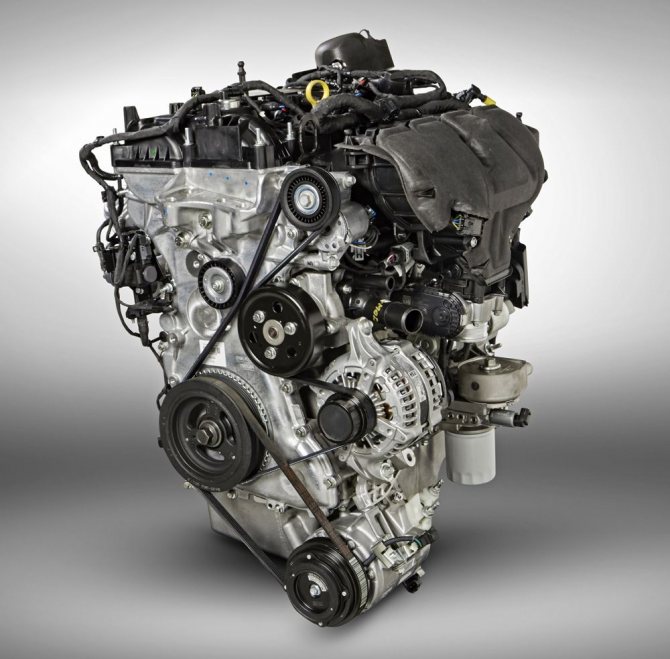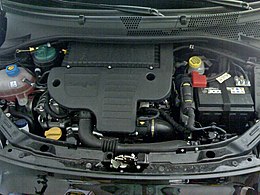
Ecoboost engine - what you should know about the Ford unit?
Content
- Basic information about Ecoboost gasoline engines
- 1.0 EcoBoost engine - technical data
- Construction of the Ford Ecoboost engine
- Twin-Scroll Turbocharger - What engines use it?
- Powertrains V5 and V6 - 2,7L and 3,0L Nano
- What made Ecoboost effective?
- Treatments affecting long engine life
- Ecoboost and environmentally friendly solutions
The first power unit was introduced in connection with the start of sales of models from 2010 (Mondeo, S-Max and Galaxy). The motor is installed on the most popular Ford cars, trucks, vans and SUVs. The Ecoboost engine has several different versions, not just 1.0. Get to know them right now!
Basic information about Ecoboost gasoline engines
Ford created a family of three- or four-cylinder in-line engines with four valves per cylinder, as well as double overhead camshaft (DOHC).
The American manufacturer has also prepared several V6 versions. The V2009 engines were developed primarily for the North American market and have been available in various Ford and Lincoln models since XNUMX.
Ecoboost engine versions and power
The number of copies released is in the millions. As a curiosity, we can say that this engine is also installed on Volvo car models - under the name GTDi, i.e. turbocharged petrol with direct injection. Ford Ecoboost engines include:
- three-cylinder (1,0 l, 1.5 l);
- four-cylinder (1.5 l, 1,6 l, 2.0 l, 2.3 l);
- in the V6 system (2.7 l, 3.0 l, 3.5 l).
1.0 EcoBoost engine - technical data
The 1.0 EcoBoost unit can certainly be included in the group of the most successful motors. It was developed in cooperation with the development centers located in Cologne-Merkenich and Danton, as well as with FEV GmbH (CAE project and combustion development).
Version 1.0 was available with 4 kW (101 hp), 88 kW (120 hp), 92 kW (125 hp) and from June 2014 also 103 kW (140 hp) .) and weighed 98 kg. Fuel consumption was 4,8 l / 100 km - it is worth noting here that the data refers to the Ford Focus. This Ecoboost engine was installed on the B-MAX, C-MAX, Grand C-MAX, Mondeo, EcoSport, Transit Courier, Tourneo Courier, Ford Fiesta, Transit Connect and Tourneo Connect models.
Construction of the Ford Ecoboost engine
The unit is equipped with several thoughtful design solutions that are also characteristic of models with a 1,5 liter engine. The designers reduced vibrations with an unbalanced flywheel, and also used a stable turbocharger that worked perfectly with direct fuel injection.
The turbine was also very efficient, reaching a peak speed of 248 rpm, and pressure fuel injection (up to 000 bar) allowed for even better atomization and distribution of the gasoline-air mixture in the combustion chamber. The injection process can be broken down into several sub-sequences, thereby improving combustion control and performance.
Twin-Scroll Turbocharger - What engines use it?
It was used in the 2,0 L four-cylinder engines that were introduced in the 2017 Ford Edge II and Escape. In addition to the twin turbo, the engineers added an upgraded fuel and oil system to the entire system. This allowed the 2.0-liter four-cylinder engine to develop more torque and a higher compression ratio (10,1:1). The 2,0-liter Twin-Scroll EcoBoost engine is also found in the Ford Mondeo and Tourneo or Lincoln MKZ.
Powertrains V5 and V6 - 2,7L and 3,0L Nano
The twin-turbo engine is also a 2,7-liter V6 EcoBoost unit with 325 hp. and 508 Nm of torque. It also uses a two-piece block and pressed graphite iron on top of the cylinders, a material familiar from the 6,7L PowerStroke diesel engine. Aluminum is used at the bottom of the rigidity.
The engine in the V6 system was a 3,0-litre nano. It was a gasoline unit with dual supercharging and direct injection with a capacity of 350 and 400 hp. It has been used for example. at Lincoln MKZ. Notable design features include an increase in bore in the CGI block to 85,3mm and an increase in stroke to 86mm compared to the 3,7L Ti-VCT Cyclone V6.
What made Ecoboost effective?
Ecoboost engines have an exhaust manifold cast together with an aluminum cylinder head. It was integrated with the cooling system and also contributed to lower exhaust gas temperatures and fuel consumption. The warm-up phase has also been shortened by installing two separate cooling circuits for the aluminum cylinder head and the cast iron cylinder block.
In the case of four-cylinder models, such as the 1.5-liter Ecoboost with 181 hp, it was also decided to use an integrated manifold, as well as a computer-controlled water pump clutch.
Treatments affecting long engine life
The Ecoboost 1.0 engine has a long service life. One reason for this is the use of a large toothed belt driving two shafts. In turn, a completely different belt drives the oil pump. The two components work in a bath of engine oil. This reduces friction and extends component life.
It was also decided to apply a special coating to the pistons and crankshaft bearings. This treatment, together with modified piston rings, reduces internal friction in the drive.
Ecoboost and environmentally friendly solutions
Ecoboost engines use solutions that not only reduce fuel consumption, but also protect the environment. In cooperation with Ford engineers from Aachen, Dagenham, Dearborn, Danton and Cologne and the specialists from the Schaeffler Group, a special automatic cylinder deactivation system was created.
How does the Ecoboost cylinder deactivation system work?
Fuel injection as well as valve actuation in the first cylinder are activated or deactivated within 14 milliseconds. Depending on the speed of the power unit and the position of the throttle valve and load mode, engine oil pressure breaks the connection between the camshaft and the valves of the first cylinder. The electronic rocker is responsible for this. At this point, the valves remain closed, thereby maintaining a constant temperature in the combustion chamber, ensuring efficient combustion when the cylinder is restarted.
The engines that we described in the article are certainly successful units. This is confirmed by numerous awards, including the "International Engine of the Year" awarded by motoring magazines UKi Media & Events for the 1.0-litre model.
Common operational problems include a faulty cooling system, but otherwise the EcoBoost engines do not cause major problems. Choosing one of the listed devices can be a good decision.
Photo gołne: Karlis Dambrans via Flickr, CC BY 2.0

